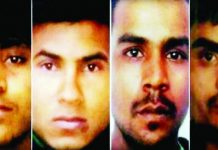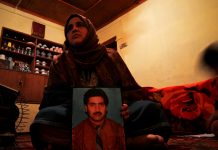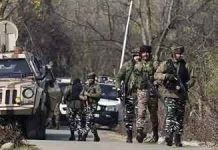
DOG-EARED textbooks and crumpled school knickers are thrown on a hardwood flatbed that is half the hut’s bare room. Forty-year-old Naori Budra limply holds a copy and stares at a handwritten page of school assignment. If she weren’t unlettered, she could have read her elder son’s uneven scrawl on it: Leher leher lehraye re mora jhanda tiranga. Translation: Wildly flutters my tricolor flag. Last week, on April 15, the paramilitary in Jharkhand allegedly shot Budra’s sons, 16 and 14 years old, claiming that they were Maoist rebels who had no faith in the sovereign Indian tricolor. “I sold my utensils to pay their fees,” Budra says, stung with rage. “My sons were no Maoists. I want them back.”
Early morning on April 22, a week after her sons were killed, dozens of rebels of the outlawed Communist Party of India (Maoist) stormed a rural railway station 20 km from Budra’s village — about 190 km west of Jharkhand’s capital, Ranchi — and shockingly took a train at gunpoint. They held an estimated 700 passengers hostage before releasing them four hours later. The hijackers demanded the arrest of those uniformed men of the Central Reserve Police Force (CRPF) who allegedly killed Budra’s sons along with their paternal uncle, his son, and another male neighbour, minutes after dragging them away from their village Badhaniya, in Latehar district, one of the state’s three most affected by Maoist violence. Before letting the train off, the rebels threatened more violence if the families of those killed were not given money and government jobs as compensation.
[box]
THE TRAIL OF VIOLENCE
Since April 1, Maoists have attacked 40 times in Jharkhand
On April 15, five innocent villagers were killed by the police
The Naxals have regrouped and launched counter attacks ever since
Six BSF solidiers and four CRPF
men were killed by Naxals in three incidents
Police admit that of Jharkhand’s 24
districts, 16 are wracked by violence
25 civilians have died in Naxal
violence since January 1, 2009. 74 were killed last year
[/box]
Maoist attacks in Jharkhand, a state of under three crore people, have risen dramatically. But the human rights watchdog group, the People’s Union for Civil Liberties (PUCL), blames the CRPF for the spiralling violence. “In the name of killing Naxals [Maoist rebels] the CRPFmostly kills innocent people,” says Shashi Bhushan Pathak, PUCL general secretary in the state (read interview here). “Adding insult to injury, its policemen are rewarded instead of being punished.” The police now say that the five men killed did not have any criminal history. “Our thinking is that it does not appear as if those men were linked with the Maoists,” Latehar Superintendent of Police Hemant Toppo told TEHELKA. “We are still investigating if they were caught in the middle when passing by.”
For the Maoists, the killing of the five men proved a godsend. To force justice for the dead, the rebels called an indefinite statewide shutdown, launching this with the train hijack on April 22. Maoist violence had already been booming in the General Election season, its scale and reach worsening when the ballot was cast on April 16 for six of Jharkhand’s 14 Lok Sabha seats. From April 1 till the concluding round of voting on April 23, the Maoist rebels had carried out no less than 40 fierce attacks across Jharkhand, killing six soldiers of the Border Security Force (BSF) and four men of the CRPF in three incidents using landmines; besides bombing schools, hospitals and health centres, police stations, railway stations, Panchayat buildings, campaign vehicles, businesses, shops, houses and roads; kidnapping poll officials; and looting electronic voting machines.
Jharkhand inherited a truncated police force of 30,000 men and an ancient armoury
“There has been a regrouping and a strengthening of the Naxal resources,” the state’s former Director General of Police until 2004, RR Prasad, who retired in 2007, told TEHELKA in Ranchi. “The threat and the challenge from them is as genuine now as it was when the state was created [in 2000].” In fact, social and rights activists, commentators and even police officers say the balance has steadily and sharply tilted in the favour of the Maoists since 2002, when the state’s first chief minister, the former Bharatiya Janata Party (BJP) strongman, Babulal Marandi, was forced out of the job.
FORMER DGP Prasad recalls that when the state was split from Bihar in November 2000, Jharkhand had inherited a truncated police force of just about 30,000 men, and sported an ancient and depleted armoury. (Now it has about 50,000 policemen.) Taking a tough line against the Maoists, Marandi quickly sought to upgrade the police force and moved to buy AK-47 guns and INSAS rifles to replace some of the archaic 303 rifles, as well as purchase anti-landmine trucks and even 600-odd jeeps to be farmed out to the state’s over 300 police stations.
Marandi, whose son was killed by the Maoists in 2007, blames the three chief ministers who succeeded him — Arjun Munda, Madhu Koda and Shibu Soren — for a lack of political will to fight the Maoists for the increase in the rebel violence. These leaders, especially Soren, repeatedly pedalled a soft line towards the Maoists claiming that the insurgents were only “our own brothers and sisters” who had gone astray and should be reconciled. Soren even suggested the government should share power with the Maoists. “It is one thing for the Maoists to attack in the cover of the night but quite another to take an entire train hostage,” Marandi told TEHELKA. “The state is non-existent in Jharkhand (read interview here).”

INDEED, THIS isn’t the first time that the Maoists rampaged openly and took a train hostage. Three years ago, in March 2006, the Maoists had taken over a train at exactly the same station and held some 100 passengers hostage. In December 2006, the rebels had attacked a train in the southern district of West Singhbhum and robbed the Railway Protection Force men of their rifles and the train guards of their wireless sets. Police officers admit that the Maoists have over the years daringly attacked policemen, police patrols and police stations at will and looted arms, including AK-47 guns.
Maoists have daringly attacked policemen at will and looted arms, including AK-47s
In the over eight years that the state has existed, several efforts to prepare a top-of-the-line police action force have come to naught. Right at the start, an exclusive commando force of some 220 policemen was raised to combat the Maoists and was used extensively initially. But it was increasingly moved to protecting ‘VVIPs’ and top police officers. After the commandos faded away, a Special Task Force (STF) was raised with about 1,000 policemen trained in counterinsurgency by the army. They too now protect ministers. Yet another attempt saw a special force of 1,500 men raised and given the name “Sengal”, which means “fire” in a local tribal language.
None of these forces were given dedicated police chiefs. Nor did they write coherent combat strategies or launch comprehensive offensives, with their own intelligence gathering and search operations. Finally, last year, the state police constituted yet another force called “Jaguar”, which has now been given the dedicated ranks of an inspector-general (IG) and a superintendent of police (SP), but is yet to show any substantial results. Four years ago, the state police placed an order with the Hindustan Aeronautics Limited to buy two helicopters especially to abet anti-Maoist operations. One such helicopter was bought in August 2007 for Rs 35 crore. It was meant for evacuation operations besides aerial survey. Until July 2008, it hadn’t been used even once.

The truth is that Jharkhand is a state where the police have been beaten hollow by the Maoist insurgency. (During a 12-hour to-and-fro car drive between Ranchi and Badhaniya village on April 21, this reporter saw not a single police patrol party, just hours before the Maoists were to launch their indefinite shutdown.) On April 22, the police did not even reach the railway station for all the four hours that the hijacked train was parked there, content with taking ineffectual helicopter rides above. Ranchi’s newspapers later reported that top police officers in Ranchi and in Latehar were asking journalists to visit the railway station and bring them details. More than a day later, the police still hadn’t visited that station.
The police didn’t reach the station for the four hours the hijacked train was parked there
“The police have vanished,” veteran social activist Ashok Rai ‘Bhagat’ told TEHELKA. His NGO, Vikas Bharati, runs social projects worth crores of rupees across Jharkhand, especially in Maoistsaffected areas where the police and the administration are practically non-existent. Last year, the Maoists burned down one of its ambulances. “I phoned the police officers,” he recalls. “They said: ‘Please handle it yourself’.”
(When TEHELKA contacted Jharkhand’s Director-General of Police, Vishnu Dayal Ram – who, besides heading the state police, is also responsible for the functioning of the CRPF in the state – and sought his response to the issues of police failure and preparedness, he said, “Wait for a few days for our response.”)
Police officers asked the media to bring them details of the train held by Naxals
THE GOVERNMENT admits that of the state’s 24 districts, as many as 18 are deeply wracked by the Maoist violence. Shockingly, in October 2007, Jharkhand Police IG (Operations) DK Pandey (who did an aerial survey of the hijacked train site last Wednesday) wrote to the SPs in 15 of these 18 districts, accusing them of not undertaking anti-Maoist combing operations, and pressing the CRPF, which is a Central force, into action while keeping the state police out of it. He reportedly sent copies of that letter to the state government, too. Nothing happened.
Predictably, it is the CRPF that has increasingly faced allegations of highhandedness or outright killing of innocents, especially whenever the Maoists attack its patrols. In fact, the killing of the five men in Budra’s village on April 15 came just an hour after suspected Maoists blew up a private bus carrying CRPF policemen barely half a km from the village, which has only about 50 houses.
“We heard a loud boom around 6 am and thick smoke went up over the road,” Budra’s husband, Soma Budra, 50, told TEHELKA, at their village, Badhaniya. Their younger son, Masih — a keen footballer who had this month passed seventh grade ranking fourth in his class — was about to head off to school but held back. For a half hour, they heard gunfire hiding in their homes. When firing ceased, a few boys and men collected in an open space and began preparations to bake mud tiles for their homes.
THEN, ABOUT 7 am, as several of them worked an earthen oven under a tree, two men in uniform drew close. “They were screaming as they came and began beating my father, brother and cousins,” recalls Sapna Budra, Masih’s 14-year-old cousin. Sapna and her two sisters watched in terror as the uniformed men took away their two male cousins; their father, Supay Budra, a permanent employee of the public sector Coal India Limited who was home for a vacation; and brother, Sanjay, who had dropped out of his Bachelor of Arts degree at St Paul’s College Ranchi last year and mostly stayed home. A neighbour named Pitay Mundu who was tending his bullocks was also taken away. Says Mundu’s sister, Suni: “We assumed our men were being taken to help the victims of the road blast.”
The problem is that politicians are using the Naxals as muscle power to settle scores
But when none returned for over two hours, the villagers sensed trouble. With his wife, Naori, and another male relative, Soma headed to a nearby township where the local Catholic priest gave them the bad news: they headed to the police station and found the five men lying dead, shot, in the back of an open tractor trolley. It would be another 48 hours before the villagers would bring the dead bodies home, after they were taken to the Latehar town 80 km away for the post-mortem.
While the police initially backed the CRPF claim that the two men and three boys were killed in an exchange of gunfire, the post-mortem report claimed that four of the men had actually died in the landmine blast. But this is refuted by news photographers who took pictures of the dead bodies as well as the villagers who later buried their dead as per tribal custom. According to them, the bodies had gaping bullet wounds but no lacerations and wounds that a bomb blast must cause. The villagers also question the post-mortem, which, they say, was carried out in the open and was finished in just minutes.
WHETHER OR not the postmortem was fixed, the fact is there is a deep distrust among the villagers towards the police over its counterinsurgency operations. An increasing number of innocent civilians are being killed in the deadly spiral of violence between the Maoists and the security forces.
According to the New Delhi-based South Asia terrorism portal, www.satp.org, which is run by former Punjab DGP KPS Gill, 25 civilians have been killed in Jharkhand in Maoist violence since January 1 this year. The number of security personnel killed during this period is 23 and the number of Maoists killed is 28. Last year, as many as 74 civilains were killed in such violence, higher than Maoists (50) and policemen (39). Of course, PUCL contests nearly all the killings of the Maoists and demands independent judicial inquiries to ascertain if they were indeed Maoists or innocent civilians that were killed by the police.
Despite its absolutely abysmal performance against the Maoists, the state government has demanded upward of Rs 7,000 crore in an ambitious plan to upgrade the police force. In its submission before the 13th Finance Commission seeking such funds, the state government has also conceded that nearly a third of all its police stations are in areas deeply affected by the Maoist violence. But of the money sought, while only Rs 100 crore will be spent on a STF, as much as Rs 1,200 crore would be spent on “police colonies”.
The biggest problem, though, in combating armed Maoist insurgency could well be that Jharkhand’s politicians are widely seen as closely integrated with the Maoists, using them as muscle power in settling political scores, especially during elections, and raising funds, through “levies”, or extortion from public spending of as much as 30-40 percent.
The Jharkhand assembly has witnessed legislators leveling open charges at each other for supporting the Maoists. A police officer requesting anonymity said that about five years ago, when he had arrested a key Maoist leader, a top state minister had phoned him to seek that man’s release.
“It is clear that the state is dead in Jharkhand,” says one of Jharkhand’s best known commentators, Harivansh, who also edits the vocal daily newspaper, Prabhat Khabar. “There is no accountability, no response mechanism for a crisis.”\
ajit@tehelka.com













